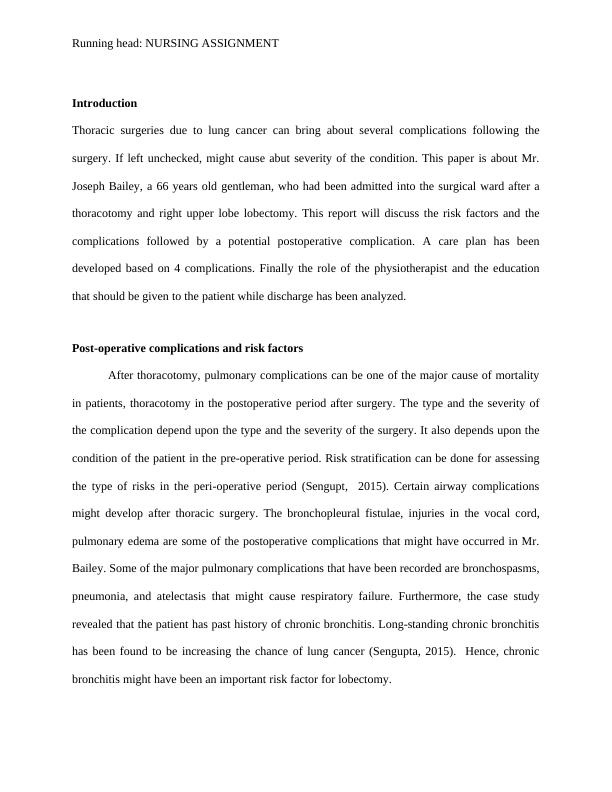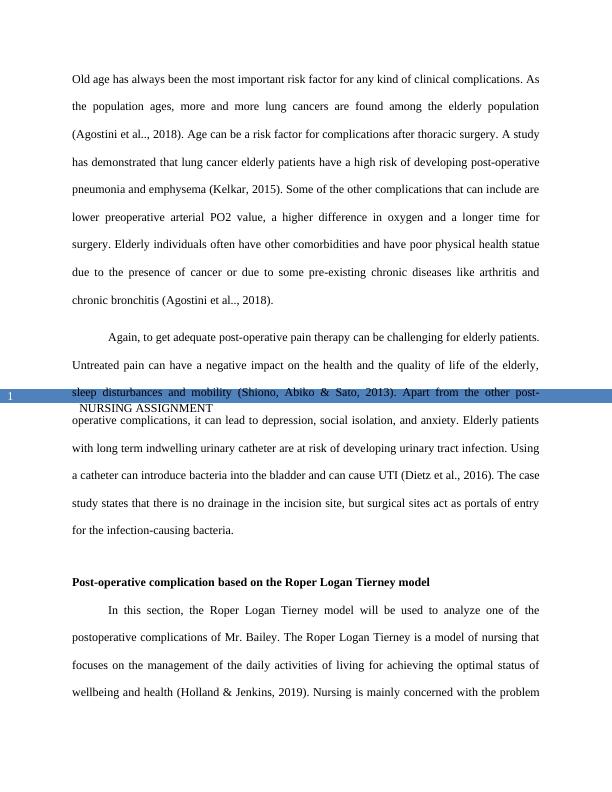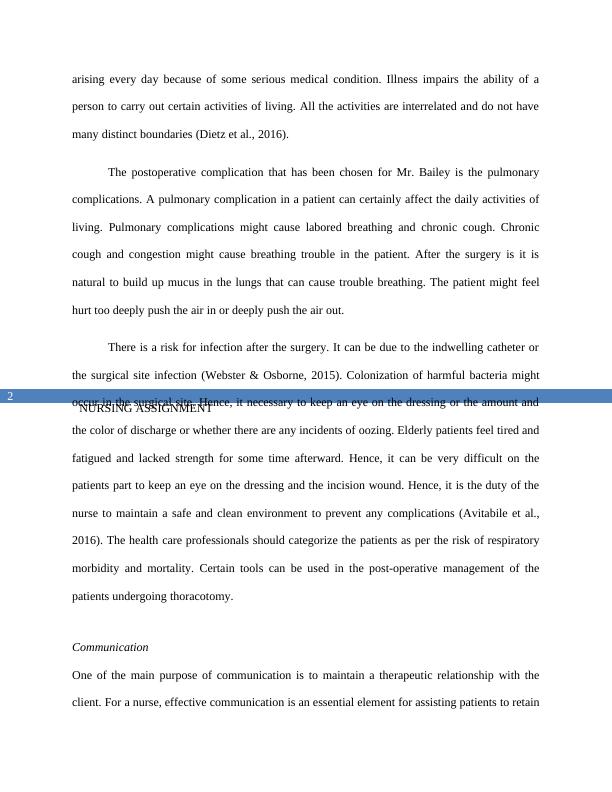Nursing Assignment | Report1
Added on 2022-10-02
16 Pages4233 Words21 Views
Running head: NURSING ASSIGNMENT
Introduction
Thoracic surgeries due to lung cancer can bring about several complications following the
surgery. If left unchecked, might cause abut severity of the condition. This paper is about Mr.
Joseph Bailey, a 66 years old gentleman, who had been admitted into the surgical ward after a
thoracotomy and right upper lobe lobectomy. This report will discuss the risk factors and the
complications followed by a potential postoperative complication. A care plan has been
developed based on 4 complications. Finally the role of the physiotherapist and the education
that should be given to the patient while discharge has been analyzed.
Post-operative complications and risk factors
After thoracotomy, pulmonary complications can be one of the major cause of mortality
in patients, thoracotomy in the postoperative period after surgery. The type and the severity of
the complication depend upon the type and the severity of the surgery. It also depends upon the
condition of the patient in the pre-operative period. Risk stratification can be done for assessing
the type of risks in the peri-operative period (Sengupt, 2015). Certain airway complications
might develop after thoracic surgery. The bronchopleural fistulae, injuries in the vocal cord,
pulmonary edema are some of the postoperative complications that might have occurred in Mr.
Bailey. Some of the major pulmonary complications that have been recorded are bronchospasms,
pneumonia, and atelectasis that might cause respiratory failure. Furthermore, the case study
revealed that the patient has past history of chronic bronchitis. Long-standing chronic bronchitis
has been found to be increasing the chance of lung cancer (Sengupta, 2015). Hence, chronic
bronchitis might have been an important risk factor for lobectomy.
Introduction
Thoracic surgeries due to lung cancer can bring about several complications following the
surgery. If left unchecked, might cause abut severity of the condition. This paper is about Mr.
Joseph Bailey, a 66 years old gentleman, who had been admitted into the surgical ward after a
thoracotomy and right upper lobe lobectomy. This report will discuss the risk factors and the
complications followed by a potential postoperative complication. A care plan has been
developed based on 4 complications. Finally the role of the physiotherapist and the education
that should be given to the patient while discharge has been analyzed.
Post-operative complications and risk factors
After thoracotomy, pulmonary complications can be one of the major cause of mortality
in patients, thoracotomy in the postoperative period after surgery. The type and the severity of
the complication depend upon the type and the severity of the surgery. It also depends upon the
condition of the patient in the pre-operative period. Risk stratification can be done for assessing
the type of risks in the peri-operative period (Sengupt, 2015). Certain airway complications
might develop after thoracic surgery. The bronchopleural fistulae, injuries in the vocal cord,
pulmonary edema are some of the postoperative complications that might have occurred in Mr.
Bailey. Some of the major pulmonary complications that have been recorded are bronchospasms,
pneumonia, and atelectasis that might cause respiratory failure. Furthermore, the case study
revealed that the patient has past history of chronic bronchitis. Long-standing chronic bronchitis
has been found to be increasing the chance of lung cancer (Sengupta, 2015). Hence, chronic
bronchitis might have been an important risk factor for lobectomy.

NURSING ASSIGNMENT
1
Old age has always been the most important risk factor for any kind of clinical complications. As
the population ages, more and more lung cancers are found among the elderly population
(Agostini et al.., 2018). Age can be a risk factor for complications after thoracic surgery. A study
has demonstrated that lung cancer elderly patients have a high risk of developing post-operative
pneumonia and emphysema (Kelkar, 2015). Some of the other complications that can include are
lower preoperative arterial PO2 value, a higher difference in oxygen and a longer time for
surgery. Elderly individuals often have other comorbidities and have poor physical health statue
due to the presence of cancer or due to some pre-existing chronic diseases like arthritis and
chronic bronchitis (Agostini et al.., 2018).
Again, to get adequate post-operative pain therapy can be challenging for elderly patients.
Untreated pain can have a negative impact on the health and the quality of life of the elderly,
sleep disturbances and mobility (Shiono, Abiko & Sato, 2013). Apart from the other post-
operative complications, it can lead to depression, social isolation, and anxiety. Elderly patients
with long term indwelling urinary catheter are at risk of developing urinary tract infection. Using
a catheter can introduce bacteria into the bladder and can cause UTI (Dietz et al., 2016). The case
study states that there is no drainage in the incision site, but surgical sites act as portals of entry
for the infection-causing bacteria.
Post-operative complication based on the Roper Logan Tierney model
In this section, the Roper Logan Tierney model will be used to analyze one of the
postoperative complications of Mr. Bailey. The Roper Logan Tierney is a model of nursing that
focuses on the management of the daily activities of living for achieving the optimal status of
wellbeing and health (Holland & Jenkins, 2019). Nursing is mainly concerned with the problem
1
Old age has always been the most important risk factor for any kind of clinical complications. As
the population ages, more and more lung cancers are found among the elderly population
(Agostini et al.., 2018). Age can be a risk factor for complications after thoracic surgery. A study
has demonstrated that lung cancer elderly patients have a high risk of developing post-operative
pneumonia and emphysema (Kelkar, 2015). Some of the other complications that can include are
lower preoperative arterial PO2 value, a higher difference in oxygen and a longer time for
surgery. Elderly individuals often have other comorbidities and have poor physical health statue
due to the presence of cancer or due to some pre-existing chronic diseases like arthritis and
chronic bronchitis (Agostini et al.., 2018).
Again, to get adequate post-operative pain therapy can be challenging for elderly patients.
Untreated pain can have a negative impact on the health and the quality of life of the elderly,
sleep disturbances and mobility (Shiono, Abiko & Sato, 2013). Apart from the other post-
operative complications, it can lead to depression, social isolation, and anxiety. Elderly patients
with long term indwelling urinary catheter are at risk of developing urinary tract infection. Using
a catheter can introduce bacteria into the bladder and can cause UTI (Dietz et al., 2016). The case
study states that there is no drainage in the incision site, but surgical sites act as portals of entry
for the infection-causing bacteria.
Post-operative complication based on the Roper Logan Tierney model
In this section, the Roper Logan Tierney model will be used to analyze one of the
postoperative complications of Mr. Bailey. The Roper Logan Tierney is a model of nursing that
focuses on the management of the daily activities of living for achieving the optimal status of
wellbeing and health (Holland & Jenkins, 2019). Nursing is mainly concerned with the problem

NURSING ASSIGNMENT
2
arising every day because of some serious medical condition. Illness impairs the ability of a
person to carry out certain activities of living. All the activities are interrelated and do not have
many distinct boundaries (Dietz et al., 2016).
The postoperative complication that has been chosen for Mr. Bailey is the pulmonary
complications. A pulmonary complication in a patient can certainly affect the daily activities of
living. Pulmonary complications might cause labored breathing and chronic cough. Chronic
cough and congestion might cause breathing trouble in the patient. After the surgery is it is
natural to build up mucus in the lungs that can cause trouble breathing. The patient might feel
hurt too deeply push the air in or deeply push the air out.
There is a risk for infection after the surgery. It can be due to the indwelling catheter or
the surgical site infection (Webster & Osborne, 2015). Colonization of harmful bacteria might
occur in the surgical site. Hence, it necessary to keep an eye on the dressing or the amount and
the color of discharge or whether there are any incidents of oozing. Elderly patients feel tired and
fatigued and lacked strength for some time afterward. Hence, it can be very difficult on the
patients part to keep an eye on the dressing and the incision wound. Hence, it is the duty of the
nurse to maintain a safe and clean environment to prevent any complications (Avitabile et al.,
2016). The health care professionals should categorize the patients as per the risk of respiratory
morbidity and mortality. Certain tools can be used in the post-operative management of the
patients undergoing thoracotomy.
Communication
One of the main purpose of communication is to maintain a therapeutic relationship with the
client. For a nurse, effective communication is an essential element for assisting patients to retain
2
arising every day because of some serious medical condition. Illness impairs the ability of a
person to carry out certain activities of living. All the activities are interrelated and do not have
many distinct boundaries (Dietz et al., 2016).
The postoperative complication that has been chosen for Mr. Bailey is the pulmonary
complications. A pulmonary complication in a patient can certainly affect the daily activities of
living. Pulmonary complications might cause labored breathing and chronic cough. Chronic
cough and congestion might cause breathing trouble in the patient. After the surgery is it is
natural to build up mucus in the lungs that can cause trouble breathing. The patient might feel
hurt too deeply push the air in or deeply push the air out.
There is a risk for infection after the surgery. It can be due to the indwelling catheter or
the surgical site infection (Webster & Osborne, 2015). Colonization of harmful bacteria might
occur in the surgical site. Hence, it necessary to keep an eye on the dressing or the amount and
the color of discharge or whether there are any incidents of oozing. Elderly patients feel tired and
fatigued and lacked strength for some time afterward. Hence, it can be very difficult on the
patients part to keep an eye on the dressing and the incision wound. Hence, it is the duty of the
nurse to maintain a safe and clean environment to prevent any complications (Avitabile et al.,
2016). The health care professionals should categorize the patients as per the risk of respiratory
morbidity and mortality. Certain tools can be used in the post-operative management of the
patients undergoing thoracotomy.
Communication
One of the main purpose of communication is to maintain a therapeutic relationship with the
client. For a nurse, effective communication is an essential element for assisting patients to retain

NURSING ASSIGNMENT
3
or regain their optimal level of functioning in every day’s life. There are various factors that can
impede the process of communication. Severe dyspnea and fatigue might refrain patients from
communicating with health care professionals (Leo et al., 2016). It is evident from this case
scenario that the patient is oriented to time and space, hence, nurses can indulge in conversation
with the client by using short necessary words in order to understand the grievances of the
patients. Nurses are also accountable to maintain a safe environment to prevent infections and
falls and should also ensure that the right dosage of medications is given at the given time.
Eating and drinking
Mr. Bailey can have bowel’s problem soon after the surgery. The patient can become
constipated after the patient starts mobilization. Fluids has to be given after the surgery to
maintain hydration. Painkillers like morphine, dihydrocodeine can cause constipation. After the
patient reaches home, ample amount of fruits and the vegetables needs to be taken. Symptoms of
aspiration are patients might occur after eating or drinking. Breathing conditions might make
eating a challenging job. In such a case, the patient can be made to eat sitting up for making
space for the lungs and diaphragm to expand, facilitating easier breathing. Since the patient is
likely to experience fatigue while eating, nurses and other health care workers might help
patients in consume food. Again individuals suffering from pulmonary complications might need
to have a restricted water intake, as water intake above 10 liters can cause acute pulmonary lung
edema (Narcı, 2013). In this way, pulmonary complication affects the daily activities like eating
and drinking (Narcı, 2013).
3
or regain their optimal level of functioning in every day’s life. There are various factors that can
impede the process of communication. Severe dyspnea and fatigue might refrain patients from
communicating with health care professionals (Leo et al., 2016). It is evident from this case
scenario that the patient is oriented to time and space, hence, nurses can indulge in conversation
with the client by using short necessary words in order to understand the grievances of the
patients. Nurses are also accountable to maintain a safe environment to prevent infections and
falls and should also ensure that the right dosage of medications is given at the given time.
Eating and drinking
Mr. Bailey can have bowel’s problem soon after the surgery. The patient can become
constipated after the patient starts mobilization. Fluids has to be given after the surgery to
maintain hydration. Painkillers like morphine, dihydrocodeine can cause constipation. After the
patient reaches home, ample amount of fruits and the vegetables needs to be taken. Symptoms of
aspiration are patients might occur after eating or drinking. Breathing conditions might make
eating a challenging job. In such a case, the patient can be made to eat sitting up for making
space for the lungs and diaphragm to expand, facilitating easier breathing. Since the patient is
likely to experience fatigue while eating, nurses and other health care workers might help
patients in consume food. Again individuals suffering from pulmonary complications might need
to have a restricted water intake, as water intake above 10 liters can cause acute pulmonary lung
edema (Narcı, 2013). In this way, pulmonary complication affects the daily activities like eating
and drinking (Narcı, 2013).

End of preview
Want to access all the pages? Upload your documents or become a member.
Related Documents
Postoperative Complications and Care Plan for a Patient with Non-Small Cell Lung Cancerlg...
|13
|3429
|154
Video-Assisted Thoracic Surgery versus Open Thoracotomy for Lobectomy for Lung Cancerlg...
|23
|5129
|48
Nursing Case: Risk Factors, Post-Operative Complications, and Care Planlg...
|11
|2119
|106
Critique of Clinical Research Paperlg...
|8
|2073
|148
Clinical Management | Presentationlg...
|17
|1561
|26
Nursing Case Study: Risk Factors and Postoperative Complicationslg...
|13
|3737
|96
